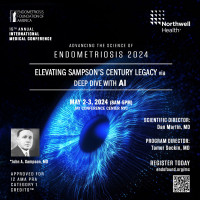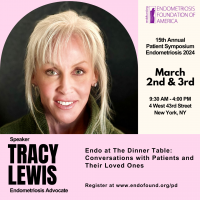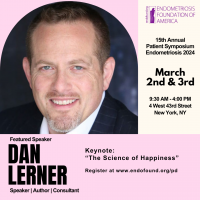Endofound’s Sixth Annual Medical Conference: Ending Endometriosis Starts at the Beginning
The ROSE Study: Investigative tools for the study of endometriosis
Peter Gregersen, MD
It is a great pleasure to be here. I want to make it clear that I am a newbie and it is actually two years ago today, around today, that Tamer Seckin came to see me out at the Feinstein Institute and started educating me about endometriosis of which I knew virtually nothing. I have spent most of my career, actually all of my career, doing genetics of autoimmunity. I am a rheumatologist by training. It has been a great pleasure over the last couple of years to get to know a lot of the people in this audience and either in person or visiting them or by phone. For those of you who have hosted me I want offer my gratitude because it has been a great learning experience.
We put together with Endofound what we are calling the ROSE study and that my thoughts about the goals of that study have changed somewhat over the year. We are now thinking in terms of these three main research goals; first to develop early diagnostics for endometriosis, which obviously from the last few talks this is a very important thing to be able to do, especially in adolescents. To comprehensively define the genetic components and really it was the genetic aspect of this disease that was one of the things that drew me to it, plus the ability to actually look at tissues for what is going on in the relevant tissues. And then, I will not talk about this much today, but Christine Metz and I have been working on thinking about laboratory assays and mouse models in order to test new approaches to disease prevention.
For the early diagnosis actually I remember walking with Tamer in London I guess nearly 18 months ago and I told him that I thought it would be really interesting to look at menstrual effluent because those are likely the cells that at least for the retrograde menstruation model are the source of the problem. We have been doing that. I will tell you a little bit about that; then to relate those changes to the genetic factors in subjects with or without endometriosis, and then explore the diagnostic utility of combining this with the genetics.
Recently it has been clear that the utopic endometrium has a different genomics going on, different patterns of expression. This is a recent paper from Linda Giudice that shows at various stages of endometrial development that there are large changes when you compare normal to subjects with endometriosis looking at endometrial biopsies. And the question is whether looking at menstrual effluent, menstrual blood actually has anything to do with the changes in the utopic endometrium. I was given an opportunity to address that without actually going into humans and repeating these studies and comparing it with menstrual effluent by working with Asgi who came to visit some months ago. I realized that he has all these samples. Not only has he also demonstrated that the utopic endometrium changes in the setting of induced endometriosis but he also had samples of endometrial tissue at the time of menstruation. He sent me those and we looked at the gene expression of those and Asgi may tell you some more about this. But basically I took the data from Linda’s reports and fortunately that data is available online as part of these papers and that is really in these days it is very critical to put your primary data online. Without the primary data you cannot do this kind of thing that I am about to tell you about, which is to look at the full change of the 320 genes or so that look different. During the menstrual phase in baboons comparing before disease and four months after disease and comparing that with the full change in mid-secretory phase that was observed by Linda Giudice in humans. In fact you can see there are very highly correlated. That was very encouraging to me because that suggested that actually looking at the phenotype of menstrual effluent could be valuable in understanding what is going on in the utopic endometrium.
We have been working on collecting menstrual effluent samples using Diva Cup. There is very high compliance with this. In fact we have had people enter our study who decided to keep using it as their routine. I think the important thing about this as opposed to uterine biopsies is that it prevents us to do population studies, large population studies that hopefully will reflect the genomics of biology of utopic endometrium in disease. We have spent a lot of time working on this doing overnight collections. We can do overnight collections in a manner that allows us to ship FedEx or have courier delivery because we have done experiments and I will show you a little data later showing that if you keep it cold you can pretty much keep it the same, it is preferable to keep it cold because if you want to grow cells, which we do, but we can also fix it and still analyze it. I think this collection is compatible with both the research and the clinical diagnostic application to look at disease heterogeneity.
I am going to show you some flow cytometry data and I realize that not everybody in this audience is familiar with flow cytometry so I am going to spend 30 seconds disclaiming how it works. Basically you take single cells and you run them in front of a laser and then you record a whole bunch of parameters. You can record 20, 30, 40 parameters over time and then correlate them in time so that they all relate to a particular cell that is going through that laser. Then you can show them in a uni-dimensional plot or in a two dimensional plot, which is very typical. Just to give you a sense of some basic stuff, if you take a light source and shine it on a cell the scatter of light going forward is a reflection of the size of the cell and a scattering of light going to the side is really a reflection of the internal granularity of the cell. If you look at a typical plot of forward scatter versus side scatter you see that lymphocytes which are small and non-granular are down here whereas neutrophils, which are larger and very granular, are over here and monocytes are in the middle.
What we did was to start characterizing the cells that are in menstrual effluent. This is a panel of antibodies for hematopoietic cells that we have used. Just to capture the basic cells that are there. And these are flow cytometry plots so again there are a lot of large granular cells which end up being granulocytes. A lot of the hematopoietic cells in there are granulocytes, about 60 percent on average. Most of the cells are hematopoietic in their origin and a small number are not. I will get back to that. Then if you take these cells that are not granulocytes you see there are monocytes here. There are T-cells, there are some B-cells and there are NK-cells that have the typical uterine NK-cell phenotype in that they do not express C-16. That was very consistent with what we expected to see and what little data there is in the literature on this issue. This is just a summary of that data showing again lots of granulocytes, T-cells, NK-cells and monocytes and very few B-cells generally.
What I wanted to emphasize is there is a huge spread here. There is a lot of variability. We do not really understand what this variability is. We are in the process of redoing people, doing multiple collections during the same cycle, during different cycles; are these distributions of cells or subsets of these cells more importantly part of the characteristic of that individual or is it just random? How much of this is random, how much is reproducible? We do not know the answer to that.
We also looked at the non-hematopoietic cells looking at basically epithelial cells, endothelial cells and what seemed to be mesenchymal stem cells, or some kind of stromal cell, and again, we do the same thing. This again is only a couple percent of the total cells that are in a standard ME sample. These down here they distribute into epithelial, endothelial cells, very few of these. Most of the cells are the stromal mesenchymal type of cells. This is the distribution of them. Again, half or more in general are these stromal type of cells and these are the cells that when we put these into culture are probably the origin of these so-called stem cells. I will not show you this but these have all the typical markers of mesenchymal stem cells. We differentiated them into bone and cartilage and they are multipotent. But the problem here is whenever you put something into culture you are modifying it. The temptation is to look at the genomics of these growing cells and that may be very valuable. I think most valuable is going to be understanding the heterogeneity of the cell population from which they come and what fraction of those cells are in fact stem cells or other cells that may be relevant to pathogenesis.
This I think opens up a tremendous opportunity to go a cell subpopulation specific approach to analysis or even single cell analysis using standard cell sorting along the lines of what I just told you about. There are now single cell microfluidics that we have been using in the lab for some of this and I am hoping that Linda Griffith is going to tell me about it in an even more fantastic way of looking at subpopulations and characterizing their phenotype.
The concept here is that there are intermediate or endophenotypes quantitative traits that will reflect the disease heterogeneity and that you can detect in menstrual effluent and that you will have candidate endophenotypes that you can understand in terms of their relationship to the genetics, to environment and to epigenetics and be able to study a whole bunch of things in these cell populations and hopefully tease apart what the underlying intermediate heterogeneity that leads to disease heterogeneity in the end.
Obviously the question is what population should we look at, obviously controls versus endometriosis but of course endometriosis is highly heterogeneous so that could get you into the same trouble that we get into with looking for other biomarkers that Stacey just referred to and that we have gotten into with genetics. I think one of the interesting things I have been talking to Stacey about starting now is to look again at the adolescent early onset disease because I think there is the high probability, there is the place where you actually could generate a useful diagnostic. I think the other higher probability population are subjects that are presenting with infertility, which we can do at our local institution with Avner Hershlag.
This is just to emphasize, this is kind of out of focus, but, that we have actually been working on the stabilization of menstrual effluent. How long can it be stable and still maintain its phenotype? Can we really do this at a distance and I think the initial results suggest that that is very doable.
Let me just talk briefly about the genetics. I come from a background looking at the genetics of autoimmune disease. The basic characteristics of endometriosis in the genetics of autoimmunity are not that dissimilar. There is modest genetic risk, modest familial aggregation, very complex, most of the genes for autoimmunity are hundreds of genes now based on the analysis of tens or even hundreds of thousands of samples in GWAS endometriosis is still in an early stage. There are less than 10,000 subjects that have been analyzed so far as a really nice meta-analysis published from Krina Zondervan’s group that summarizes this. But there are clearly a lot more genes to be found.
One of the considerations with genetics and we are confronting everybody that is working on genetics of complex diseases confronting this you have these hits but it is not exactly clear what the gene is in the locus or indeed what the causative variant is. Each identification of a causative variant in any of these locations really depends on sequencing the entire region and correlating it with some function that makes sense for disease because these genes are not associating with disease per se they are associating with endophenotypes with quantitative traits that in combination lead to disease. That is why I think it is very important to use these quantitative traits whether it is in ME or someplace else to analyze the genetics. A lot of these genes are going to be regulatory. We know that from other studies. The thing I want to emphasize I think there is a real opportunity that has not really been pushed in the endometriosis field is that sometimes there are rare highly penetrant genotypes that lead to a phenotype that may look very similar to what you are looking at. There are plenty of examples of this in Lupus, there are examples in RA, there are examples in type I diabetes and I think the most exciting and clinically relevant example is actually PCSK9 which controls LDL cholesterol.
And in fact, just to summarize this is a little publication in Science from Helen Hobbs who made some of these early observations. Basically in 2003 there was a family with dysfunction of this gene, rare variant. They had familial hypercholesterolemia but then Helen discovered that actually in especially the African-American population there is a subset, an uncommon subset of people that have a loss of function variant and that leads to a dramatic reduction in cholesterol, reduction in coronary heart disease and this is now a topic for a focus of therapeutics by two or three major companies. It is an example of how going into rare instances of phenotypes and finding rare variance can really trigger major advances. It would not be at all surprising to me to find families, multiplex families who have this kind of genetics going on.
That is something that I think the entire community has to be aware of. Hopefully we can integrate that into a broad collaboration among laparoscopic surgeons. I have discussed this with many of the surgeons in this room. I have been out to Juno Biosciences to talk with them who have actually done quite a bit of genetics. I think they are extremely open to collaboration with the community. We need to define subsets of disease and because of the heterogeneity whether it is acquired or developmental that is going to confuse things unless we try to define that with some kind of phenotyping. Of course the more subsets there are the larger the sample size requirements are going to be.
I think we should be thinking in terms of sample sizes of 30,000, 40,000 in order to capture the power. Getting large numbers and there is focusing on highly penetrant disease in families. I think those are the ways to make it forward. I think there are other possibilities here, opportunities. The Amish population I was fascinated to go out and see Andy Cook who told me about patients of his from the Amish community. We have already started recruiting them. The Amish are a highly inbred and founder effect community likely to be very, very informative for this. I have talked to Adel Shervin and his colleagues in Tehran about middle-eastern populations. There again there are consanguineous marriages there seems to be very serious disease. I hope we go forward with our governments because I think it is going to open up the possibility of actually studying that population if we can actually reach some political agreement with Iran.
I think there is room now for focused up application of genome sequencing cost of whole genome sequencing is about $1500. We have done several thousand so far in RA so there are large control data sets and I would look to do this on some of these specialized populations.
Obviously collaboration is key. You are not going to get there without having the entire community contributing to this and that includes folks at my place, Tamer of course has been a major driver for me in this. Stacey and Asgi have been great as collaborators and many other people are or will be shortly collaborating I hope. Thank you very much.
Audience Member: Hello, I have a quick question about the Diva Cup. I have worked with women who have had difficulty using the Diva Cup. I am thinking specifically about adolescents who may not be sexually active. Would this disqualify them if they are not able to insert the Diva Cup?
Peter Gregersen, MD: Yes, we have actually, it is interesting, one of the – I have a nursing staff who are very excellent at talking to people about using this. Actually the person I mentioned that is now using it routinely had tremendous difficulties initially and then got over that. I cannot speak to early adolescence before sexual activity. I am not even sure if we enrolled anybody so I do not know if that is going to work and that may be a limitation.
Robert Taylor, MD: Very nice talk, really exciting stuff. I was intrigued actually so if one to four percent of the cells are what we would think of as traditionally endometrial, epithelial, stromal, vascular endothelium, obviously there is going to be a subset of the immune cell population that probably is resident but it strikes me that the majority of your cells are probably derived from the circulation itself, which really suggests that we may be getting closer and closer to a blood based diagnostic approach. Do you have thoughts about that? Obviously this is a great step through to that maybe that is shooting too far, too high, but it would seem to me that if you can identify a subset of cells that are likely to be actually kind of falling out of the circulation into your Diva Cup we might be able to get those out of venipuncture.
Peter Gregersen, MD: I think that is possible. But on the other hand it is pretty striking that the NK cells are there that are not from peripheral blood because they lack CD16 and I think we just do not know enough about the other subsets of T-cells for example. There is very little work done on T-cells. Are there T-reg cells in there that are really important for controlling things? Are the monocytes poised to differentiate into M1 or M2? I think there are a lot of issues of the diversity of these cells in situ that are as important to address. I agree that it may lead us to something that is in the periphery. My guess would be a soluble product but it could be a cell.










